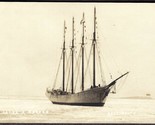Schooner Laura A. Barnes RPPC Launched 1918 Camden Maine Wrecked 1921
Ships from
United States

Don't miss out on this item!
There is only 1 left in stock.
Shipping options
Estimated to arrive by Mon, Aug 18th.
Details
This estimate is based on:
- The seller's handling time
- unspecified transit time to Canada
Actual delivery times may vary.
Have shipping questions? Contact the seller
Calculated by USPS in Canada.
Ships from
United States

Return policy
Full refund available within 30 days
Payment options
PayPal accepted
PayPal Credit accepted
Venmo accepted
PayPal, MasterCard, Visa, Discover, and American Express accepted
Maestro accepted
Amazon Pay accepted
Nuvei accepted
Shipping options
Estimated to arrive by Mon, Aug 18th.
Details
This estimate is based on:
- The seller's handling time
- unspecified transit time to Canada
Actual delivery times may vary.
Have shipping questions? Contact the seller
Calculated by USPS in Canada.
Ships from
United States

Return policy
Full refund available within 30 days
Payment options
PayPal accepted
PayPal Credit accepted
Venmo accepted
PayPal, MasterCard, Visa, Discover, and American Express accepted
Maestro accepted
Amazon Pay accepted
Nuvei accepted
Item traits
| Category: |
Topographical Postcards
|
| Quantity Available: |
Only one in stock, order soon
|
| Condition: |
Unspecified by seller, may be new.
|
Antique Real Photo Postcard, circa 1920. Identified as the Schooner Laura A. Barnes. Published by Hall Studio. Divided back, AZO stampbox, unused. Condition: This is an original photo postcard, not a copy or reproduction. It is in excellent condition, with very light corner strap marks from storage in a postcard album. Comments: (From the Carolina Designs website:) Built by the R.L. Bean Shipyard in Camden, Maine, the Laura A. Barnes was almost 180 in length and could carry 530 tons of cargo. Owner/Captain Charles Barnes named the ship for his wife, Laura Annie Barnes and when she was launched on March 15, 1918, she was one of 20 four-masted schooners that the R.L. Bean Shipyard built over a 20 month period that is a record that still stands for construction of ocean-going schooners. Although a wooden cargo ship, when launched, according to reports of the day, she boasted many of the most recent refinements in commercial shipping. Certainly, the fact that she was a four-masted schooner but only needed a crew of eight would indicate that some of the most recent innovations in sail design had been built into her. Intended to carry cargo along the profitable coastal run along the Atlantic seaboard, the ship had two years on the sea before her fateful journey in May of 1921. The record is a little unclear about that last trip along the coast. The Laura A. Barnes was based out of Marblehead, Massachusetts where the Barnes family lived. She set sail in late May for Georgetown, South Carolina, but the ships manifest did not list any cargosomething that is somewhat odd. The ship was probably headed to South Carolina to pick up cargo, but shipowners very rarely sailed with an empty hold. May 31, 1921 was a fog-shrouded stormy night. At some point in the overnight hours, pushed by high winds, buffeted by the seas and unable to see where the ship was headed in the fog, the Laura A. Barnes ran aground on Bodie Island. The Coast Guard stations along the Outer Banks included foot patrols along the beach during the 1920s and it was surfman H.N. Etheridge who first saw the ship hard aground on Bodie Island. Surfmen from the Bodie Island and Nags Head Coast Guard stations participated in the rescue, using a fireable beach apparatus, probably a reference to a Lyle Gun. Lyle Guns were standard issue rescue equipment for all Lifesaving and Coast Guard Stations from the 1880s until 1952. A line was attached to a 19-pound projectile that the gun would fire to a ship in distress. The line was attached to the ship and became part of a lifeline to get personnel off the ship in distress. All eight crewmen were rescued from the ship, but the ship was a total loss. According to some sources, Captain Barnes was able to sell the contents of the ship to wreckers for $80,000 who probably removed everything of value from the interior. The ship originally ran aground about one mile south of its current location at Coquina Beach. In 1983 the National Park Service moved the wreck to its current site. At times the wreck is easily seen. At other times, sand and tides cover it almost entirely.
